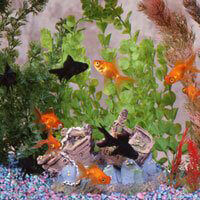Caring for Fish
Fragile tropical fish, who were born to dwell in the majestic seas and forage among brilliantly colored coral reefs, suffer miserably when forced to spend their lives in glass aquariums. The same is true of river fish. Robbed of their natural habitats and denied the ability to travel freely, they must swim around in the same few cubic inches of water over and over.
Where Fish Really Come From
The popularity of keeping tropical fish has created a virtually unregulated industry that catches and breeds as many fish as possible with little regard for the animals themselves. While many species of coral are protected under the Convention on the International Trade in Endangered Species, most of the fish who end up in aquariums are not.
An estimated 95 percent of saltwater fish sold in pet shops came from the wild, mostly from the waters around Indonesia, the Philippines, Fiji, and other Pacific islands. Collectors douse the coral reefs with cyanide, which is ingested by the fish who live there, and as reported in Scientific American, “[t]he resulting asphyxiation stuns some fish and sends others into spasms, making them easy to grab by hand or net.” Half the affected fish die on the reef, and 40 percent of those who survive the initial poisoning die before they reach an aquarium. Cyanide also kills the coral reefs themselves, and marine biologists rank it as one of the biggest dangers in Southeast Asian waters.
Goldfish are usually raised in giant tubs on fish farms that raise as many as 250 million fish per year. These animals are sold to zoos, pet stores, and bait shops, and many are doomed to live in plastic bags or bowls, neither of which provide the space or oxygen that goldfish need. In 2004, the city of Monza, Italy, banned keeping goldfish in bowls because the containers do not meet the needs of the animals and because, as one sponsor of the law pointed out, bowls give fish “a distorted view of reality.”
Some fish farms are seeking new market niches by creating fish breeds that would never occur in nature, treating fish as ornaments instead of living animals. Some breeders even “paint” fish by injecting fluorescent dyes into the animals’ bodies or altering their genetic makeup to make them more attractive to buyers.
Fish Can Speak, Make Tools, and Think
Fish have cognitive abilities that equal and sometimes surpass those of nonhuman primates. They can recognize individuals, use tools, and maintain complex social relationships. Biologists wrote in the journal Fish and Fisheries that fish are “steeped in social intelligence, pursuing Machiavellian strategies of manipulation, punishment and reconciliation, exhibiting stable cultural traditions, and co-operating to inspect predators and catch food.”
Fish communicate with one another through a range of low-frequency sounds—from buzzes and clicks to yelps and sobs. These sounds, which are audible to humans only with the use of special instruments, communicate emotional states such as alarm or delight and help with courtship. The pumps and filters necessary in many home aquariums can interfere with this communication. “[A]t the least, we’re disrupting their communication; at worst, we’re driving them bonkers,” says ichthyologist Phillip Lobel.
Siamese fighting fish, who are often sold as “decorations” or party favors, are fighting for their lives as their popularity grows. Pet shops, discount superstores, florists, and even online catalogs sell Siamese fighting fish (also called betta fish) in tiny cups or flower vases to consumers who are often uneducated about proper betta care.
Many people mistakenly believe that betta fish must be isolated and that they can survive without being fed in a so-called “complete ecosystem” that consists of nothing more than a vase and a plant. As a result, fish are being sentenced to dull, lonely lives and slow deaths by starvation. These tiny containers are not suitable for any fish. While betta males do not get along well with each other, they are able to live with other types of fish in a “community” aquarium.
Biologists say that there is no safe way to return captive fish to their natural environments—which are often located in a completely different region of the world—because of the difficulty in locating such a habitat and the possibility of introducing disease to the other fish there. Researchers have found many species of non-native fish living off the coast of Florida (including predatory species), and they attribute these populations to careless aquarium owners. These fish pose a real threat to native species. Never flush fish down the toilet in the hopes of “freeing” them, as seen in the popular movie Finding Nemo. Even if a fish survived the shock of being put into the swirling fresh water, he or she would die a painful death in the plumbing system or at the water treatment plant.
What You Can Do
Please don’t support the tropical-fish trade by purchasing fish. If you enjoy watching fish, consider downloading one of the many colorful and realistic fish computer screensavers available on the Web. Don’t support businesses or fairs that give fish away in contests or promotions.
If you already have fish, you can make their lives easier by providing them with an environment that is as much like their natural habitat as possible. While captive fish can never live natural lives, the following tips will help ensure that they are as happy as possible:
- The more space that fish have, the happier and healthier they will be. Their needs can vary, so check with an expert or consult a good fish book to determine their requirements. One general guideline is that you should provide 3 gallons for every 1 inch of fish.
- Treat tap water properly before putting it in the aquarium, as most municipal water has chlorine in it, which can kill fish. The type of chemicals that you should use depends on your area’s water. Consult with a local tropical-fish supply store to determine the proper treatment.
- Different types of fish require different pH levels. Check the pH level daily for the first month and weekly thereafter.
- A filter to remove waste particles and noxious chemicals from the water is essential. Live plants help with this task and provide oxygen, shelter, hiding places, and the occasional snack.
- A properly working air pump is necessary to provide oxygen.
- Fish need a constant temperature, generally between 68°F and 76°F, but you should check with a fish supply store for information that is specific to the type of fish that you are keeping. Automatic aquarium heaters monitor the water temperature and turn the heater on and off as needed. Attaching a small thermometer to the tank will help you ensure that the heater is functioning properly.
- The natural waste of fish emits ammonia, which can accumulate to toxic levels, so clean the tank regularly, but never empty the tank completely. Be sure to clean the glass well with a pad or a brush to prevent algae growth.
- Create places for the fish to hide in and explore. Ceramic objects, natural rocks, and plants work well. Make sure that all objects are thoroughly cleaned and disinfected before they are put into the tank. Do not use metal objects, as they will rust.
- Be aware of the environment outside the aquarium. Suddenly switching on a bright light in a dark room can startle fish, and vibrations from a television or a stereo can alarm and stress them.
- Keep all harmful chemicals away from the aquarium. Cigarette smoke, paint fumes, and aerosol sprays can be toxic if they are absorbed into the water.
- The aquarium should be in a spot where temperature and light are constant and controllable. Tropical-fish supply stores may be able to advise you on the best amount of light for the fish you are keeping. Remember that direct sunlight and drafts from nearby doors or windows can change the water temperature, and fumes from a nearby kitchen or workshop can injure the fish.
- Don’t overfeed! Uneaten food and waste material are broken down into ammonia and nitrites, which are toxic. One expert recommends providing only as much food as your fish can eat in 30 seconds.
- If a fish seems sick or lethargic, take him or her to a vet. Fish can be medicated, anesthetized, given shots, and operated on, just like other animals. Take along a separate sample of the tank water.
- Most fish enjoy companionship. If you have a single fish, check with friends and neighbors to find another loner to adopt—but don’t support the fish trade by going to a dealer.









